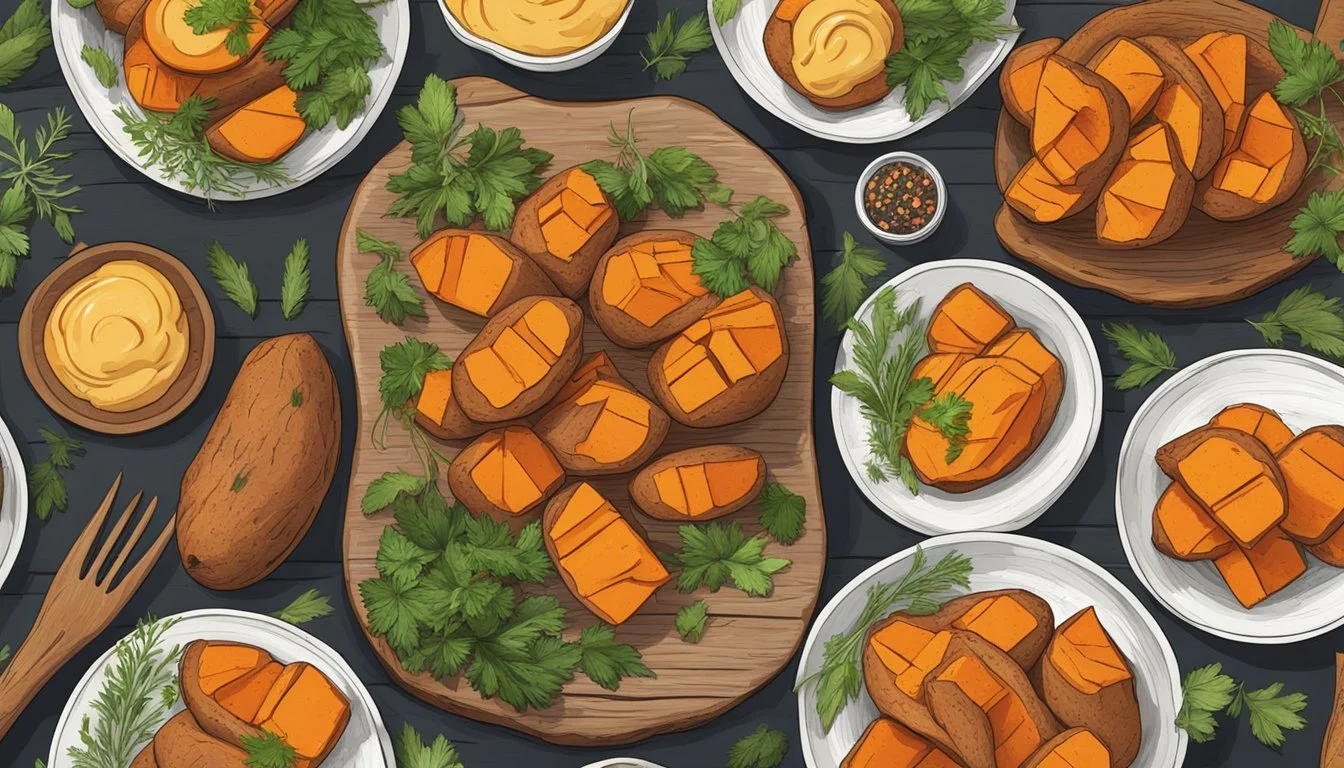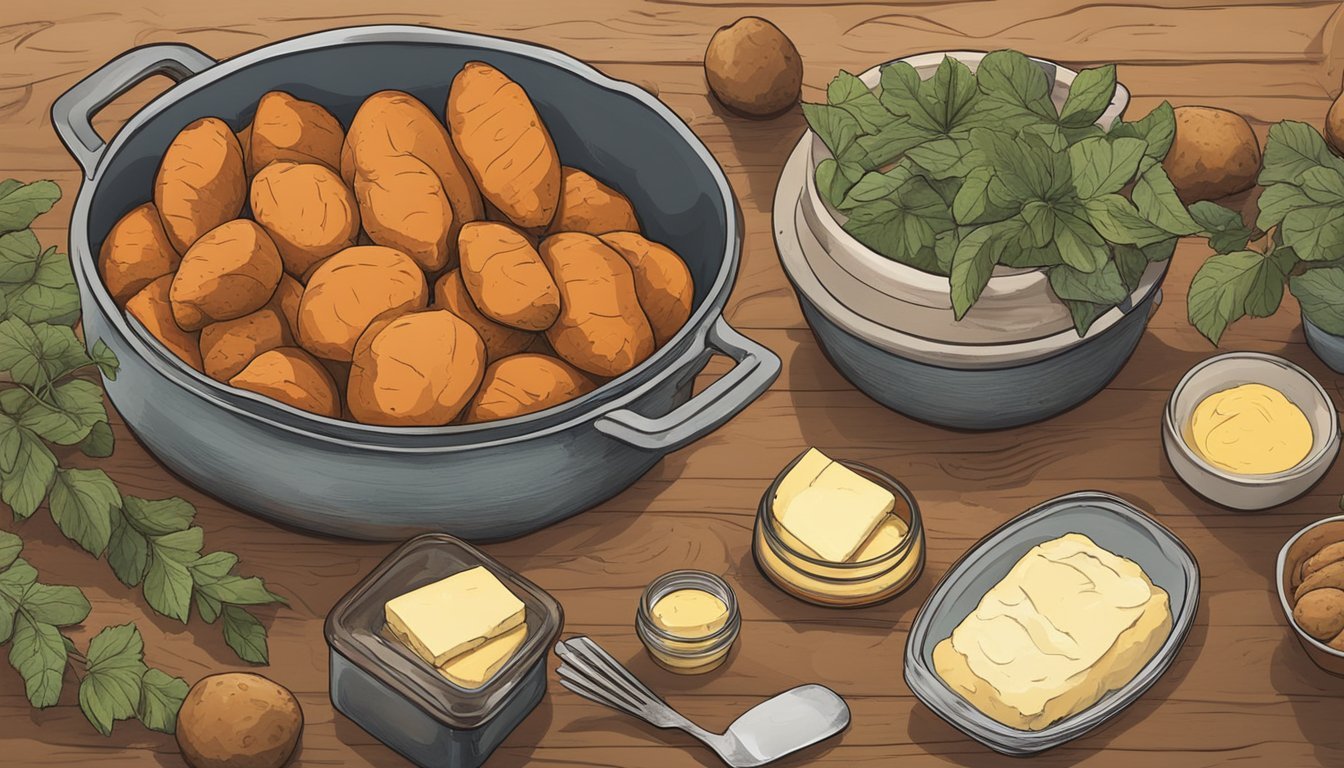Cowboy Butter Baked Sweet Potatoes
The Perfect Balance of Flavor and Nutrition
Sweet potatoes (What wine goes well with potatoes?) have secured their place in the pantheon of nutritious foods, offering a wealth of benefits along with a sweet, comforting flavor. They are a versatile root vegetable that can be prepared in a multitude of ways, but baking them in the oven enhances their natural sweetness and concentrates their flavor. An increasingly popular way to enjoy baked sweet potatoes (What wine goes well with sweet potatoes?) is with cowboy butter, a seasoned, herb-infused compound butter that adds a rich, savory depth to the dish. This culinary combination not only creates a flavorful experience but also maintains the health benefits of the sweet potato.
Rich in vitamins, fiber, and antioxidants, sweet potatoes serve as a healthful option whether they are the star of the show or playing a supportive role as a side dish. When baked, their flesh becomes tender and caramelized around the edges, providing a perfect canvas for the bold flavors of cowboy butter. This butter blend typically includes garlic, parsley, chives, red pepper, and lemon, ingredients that not only complement the sweet potato's taste but also offer their own nutritional perks.
Creating cowboy butter baked sweet potatoes requires minimal preparation, making it an accessible option for any level of home cook. The simplicity of the cooking process allows the natural complexity of the sweet potato to shine through, punctuated by the zesty notes of the cowboy butter. Whether served alongside a protein or as a vegetarian main course, this dish is a testament to the sweet potato's delightful versatility and enduring appeal.
The Nutritional Profile of Sweet Potatoes
Sweet potatoes are a nutritional powerhouse, providing a rich array of vitamins, minerals, and macronutrients. They offer significant health benefits as a high-fiber, low-fat option with a substantial vitamin and mineral content.
Vitamins and Minerals
Sweet potatoes are especially renowned for their high vitamin A content. They supply a substantial amount of this vitamin, which is crucial for maintaining healthy vision, immune function, and skin integrity. They are also a good source of vitamin C and vitamin B6, both of which are essential for the proper functioning of the immune and nervous systems, respectively.
Apart from these vitamins, sweet potatoes offer a variety of minerals. Notably, they contain potassium, which is key for heart health and proper muscle and nerve function. They also provide smaller amounts of calcium and iron, which are essential for bone health and oxygen transport in the blood.
Vitamin A: Critical for eyesight and immune health.
Vitamin C: Important for immune system support and collagen production.
Vitamin B6: Necessary for cognitive development and immune function.
Potassium: Vital for blood pressure regulation and muscle function.
Calcium: Essential for bone health and muscular activity.
Iron: Integral for oxygen transport and energy metabolism.
Macronutrient Breakdown
Sweet potatoes contain a balanced macronutrient profile that includes carbohydrates, fiber, protein, and a minimal amount of fat. The carbohydrates present in sweet potatoes are primarily composed of starches and natural sugars, providing a steady release of energy.
Carbohydrates: A medium-sized sweet potato contains about 32.7 grams of carbohydrates, which includes starch, natural sugars, and dietary fiber, contributing to satiety and digestive health.
Fiber: With approximately 6 grams of fiber in a large sweet potato, this nutrient is essential for maintaining a healthy digestive system and keeping blood glucose levels stable.
Protein: Sweet potatoes provide a modest protein content, around 3.2 grams for a medium-sized one, beneficial for tissue repair and growth.
Fat: They have a low-fat content, typically only 0.2 grams for a medium-sized sweet potato, which makes them a heart-healthy choice.
Sodium: Naturally low in sodium, they are a good choice for a heart-healthy diet.
Cholesterol: Sweet potatoes contain no cholesterol, making them a smart choice for maintaining healthy cholesterol levels.
The absence of cholesterol and the low levels of fat and sodium in sweet potatoes make them an ideal option for those looking to manage their weight or cardiovascular health. The substantial fiber content is not only beneficial for digestion but also helps in the regulation of blood sugar levels, making it a favorable food for individuals with diabetes. Their diverse and rich nutritional profile establishes sweet potatoes as a valuable addition to any meal, functioning well as either a side or a main course.
Preparing and Baking Sweet Potatoes
Creating a perfect Cowboy Butter Baked Sweet Potato begins with key steps: selecting high-quality sweet potatoes and using proper preparation and baking techniques. Each phase is crucial to ensure the sweet potatoes are flavorful and have the ideal texture.
Selecting the Best Sweet Potatoes
To ensure the best results, one must begin by choosing the right sweet potatoes from the store. Look for sweet potatoes that are firm, without any soft spots or signs of decay. The skin should be smooth and even. Sweet potatoes with tight skin and minimal eyes will bake the most evenly. Moreover, consistent size among the sweet potatoes chosen will promote uniform cooking.
Preparation Techniques
Before baking, sweet potatoes must be prepared properly:
Cleaning: Rinse under cool water and scrub the skin with a brush to remove any dirt.
Drying: Pat the sweet potatoes dry since excess moisture can affect the cooking process.
Piercing: Using a fork, prick the sweet potato skin 3-4 times to allow steam to escape during baking.
Oil and Seasoning: Coat the skin lightly with olive oil, then season with salt and pepper to enhance flavor and help the skin crisp up.
Baking Sweet Potatoes 101
For perfectly oven-baked sweet potatoes:
Preheat the oven to 425°F (218°C) to ensure a crispy skin.
Line a baking sheet with parchment paper or aluminum foil for easy cleanup.
Place the sweet potatoes on the baking sheet.
Bake for about 45-60 minutes, or until a fork can easily pierce the sweet potato's skin and flesh.
Oven temperature and cooking time might vary slightly based on the sweet potato's size and the oven's calibration. Check at the 45-minute mark to gauge doneness.
Alternative Cooking Methods
Aside from traditional baking, there are alternative methods to cook sweet potatoes:
Microwave: For a quicker option, sweet potatoes can be microwaved on high for about 5-10 minutes, turning halfway through.
Steam: Steaming sweet potatoes preserve more nutrients than boiling and can be done in a steamer basket or using a microwave with a special steaming tray.
Instant Pot: For the pressure-cooking aficionados, sweet potatoes can be cooked in an Instant Pot with water for about 15 minutes.
Remember that when preserving leftovers, sweet potatoes should be stored in an airtight container. They can be kept in the refrigerator for up to 5 days, freeze well, and can be easily reheated in an oven or microwave.
Cowboy Butter Baked Sweet Potatoes
Sweet potatoes transform into a mouthwatering side dish or main course when topped with rich and flavorful cowboy butter. This section details the process, from the key ingredients to the final toppings, focusing on creating a dish that's both delectable and nutritious.
Key Ingredients for Cowboy Butter
Cowboy butter is a compound butter that brings a symphony of tastes to any dish. The key components include:
Unsalted butter for a creamy base.
A mix of herbs such as parsley, chives, and thyme.
Garlic, chili powder, and crushed red pepper for a savory kick.
Lemon zest and juice for a citrusy accent.
Mustard to add depth.
Seasonings like smoked paprika, kosher salt, and ground black pepper for balance.
Combining Flavors
Mix the softened unsalted butter with finely minced garlic, herbs, and the rest of the seasonings. Stir until the mixture is uniform. Adjust the seasonings to taste, looking for a balance that complements the sweet potatoes' natural sweetness.
Applying Cowboy Butter to Sweet Potatoes
Preheat the oven to 375°F (190°C). Wash and dry the sweet potatoes, pierce their skin, and rub them with olive oil and a sprinkle of kosher salt. Once they are tender and baked, slice them open and apply a generous amount of cowboy butter on top, allowing it to melt and seep into the soft flesh.
Final Touches and Toppings
For a sweet variant, drizzle maple syrup or sprinkle a blend of brown sugar and cinnamon over the buttered sweet potatoes. For something more savory, consider a pinch of sea salt or a dash of hot sauce. Doubling as a topping, cowboy butter itself is rich in flavor, reducing the need for additional fat or sugar.
Serving Suggestions
Cowboy Butter Baked Sweet Potatoes can be served as a nutritious side to proteins such as fish or pork, or they can be the main showing, especially when combined with a topping like black beans and salsa. Garnish with sour cream and chives for added taste and texture.
Dietary Adjustments
Swap traditional butter for a plant-based alternative to cater to those on vegan diets. For those watching their sodium intake, use sea salt sparingly. If necessary, adjust the level of chili to manage the heat for each palate. As a versatile dish, Cowboy Butter Baked Sweet Potatoes can be customized to fit a range of dietary needs and preferences.
Exploring Sweet Potato Variations
Sweet potatoes, with their beautiful orange flesh, can be transformed into a myriad of dishes, ranging from the classic oven-roasted side to sweet, dessert-like casserole. This versatility allows chefs and home cooks to experiment with both sweet and savory flavors, finding a place for sweet potatoes in every meal.
Sweet Versus Savory Dishes
Sweet potatoes can be the foundation of both sweet and savory dishes. They naturally possess a richness that pairs well with sugar, cinnamon, and marshmallows in a sweet potato casserole, often served during Thanksgiving. Conversely, baked sweet potatoes gain a versatile savory note when topped with ingredients like salt, chili, or herbs—creating a balance between the soft, fluffy interior and the crispy skin.
Incorporating Sweet Potatoes into Different Meals
No meal is off-limits when it comes to incorporating sweet potatoes. For breakfast, sweet potato pancakes or mashed sweet potatoes offer a nutritious start to the day. Come lunchtime, a simple oven-roasted sweet potato can become a hearty base for a loaded sweet potato with various toppings. Dinner might showcase sweet potatoes in a satisfying shepherd’s pie, reflecting their utility as both side and main course.
Creative Sweet Potato Recipes
Home cooks and chefs alike continue to invent amazing recipes that elevate the sweet potato beyond its traditional uses. Sweet potato recipes are widely shared across social media platforms like Instagram, Pinterest, and Facebook. Whether it's roasted sweet potatoes with a drizzle of honey and brown sugar for extra caramelization or a baked sweet potato left to get slightly crispy in the skin, the options are countless. Here’s a brief listing to inspire:
Desserts: Cinnamon and Honey Sweet Potato Mash
Appetizers: Crispy Sweet Potato Skins with Marshmallow Dip
Entrees: Sweet Potato Shepherd’s Pie
Sides: Thyme-Infused Roasted Sweet Potatoes
The leftovers, if any, provide an excellent opportunity to get creative with the next day's meals or to inspire content for an ebook or newsletter for the avid home cook.
Tips for Storing and Preserving Sweet Potatoes
Selecting and storing fresh sweet potatoes correctly extends their shelf life, while preserving baked sweet potatoes properly ensures that their delicious flavors are maintained. Below are specific strategies for retaining the quality of both fresh and baked sweet potatoes.
Storing Fresh Sweet Potatoes
Selecting Sweet Potatoes: Choose sweet potatoes that are firm and free from cracks, soft spots, and blemishes. A consistent, bright color is a good indication of quality.
Ideal Conditions: Store fresh sweet potatoes in a cool (55° to 60°F), dark, and dry place to prevent spoilage. Never refrigerate them, as cold temperatures can alter their taste and texture.
Humidity: If possible, maintain a humidity level of 90-95% to facilitate the curing process, which enhances their natural sweetness and extends shelf life.
Ventilation: Ensure that the storage area is well-ventilated to prevent the accumulation of moisture which can lead to rot.
Inspection: Regularly check for signs of spoilage or decay and remove any affected sweet potatoes to prevent it from spreading.
Preserving Baked Sweet Potatoes
Cooling Down: Before preserving, allow baked sweet potatoes to cool to room temperature to avoid condensation which can lead to a soggy texture.
Refrigeration: Store leftovers in an airtight container and refrigerate for up to a week. Ensure the container is sealed properly to avoid moisture loss.
Freezing: For long-term preservation, wrap the baked sweet potatoes individually in aluminum foil or place them in an airtight container before freezing. This method can retain quality for several months.
Reheating: To reheat, remove the sweet potatoes from the freezer and warm them in an oven or microwave. When reheating in the microwave, use 30-second intervals, checking between to avoid overheating. For a creamy consistency, add a touch of water or cream if reheating mashed sweet potatoes on the stovetop.
Health Considerations and Allergies
When enjoying Cowboy Butter Baked Sweet Potatoes, one should be aware of the nutritional values they offer, along with any potential allergens. Sweet potatoes are a nutrient-dense food high in fiber and vitamin A, and when topped with cowboy butter—a mixture that often includes butter, garlic, and herbs—the dish becomes a flavorful addition to any meal that's naturally gluten-free.
Understanding Sweet Potato Allergens
Sweet potatoes themselves are not commonly allergenic foods and are generally safe for most people to consume. They do not contain gluten, making them a suitable option for individuals with celiac disease or gluten sensitivity. However, toppings or additives, such as those found in cowboy butter, might contain allergens. Ingredients like dairy in butter can cause allergic reactions in some people. It's essential for individuals with known food allergies to check the labels of commercial cowboy butter or inquire about the components if dining out.
Relevant points for individuals with dietary considerations:
Sweet Potatoes: Gluten-free, very low in fat, cholesterol, and sodium.
Cowboy Butter: May contain dairy; homemade versions can be adapted using dairy-free alternatives.
Balancing Sweet Potatoes in a Healthy Diet
Sweet potatoes are a highly nutritious choice. They provide a good source of dietary fiber, which can aid in digestive health, and they offer an impressive amount of vitamin A—essential for eye health, immune function, and skin health. However, even healthy foods should be eaten in moderation as part of a balanced diet. When baked sweet potatoes are loaded with cowboy butter, the fat content increases. To maintain the dish's health benefits, one might consider using cowboy butter sparingly or modifying it with healthier fats like olive oil or yogurt as a substitute for butter.
Nutritional balance tips for Cowboy Butter Baked Sweet Potatoes:
Portion Control: Use cowboy butter in moderation to keep additional fat intake in check.
Yogurt Substitute: Opt for Greek yogurt as a healthier alternative to butter for added protein and reduced fat.







